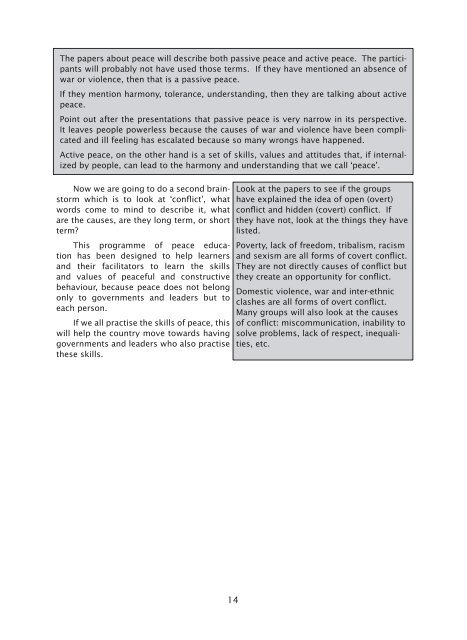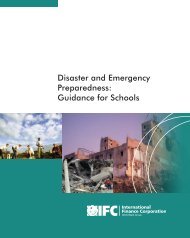Manual for training of facilitators (community component ... - INEE
Manual for training of facilitators (community component ... - INEE
Manual for training of facilitators (community component ... - INEE
You also want an ePaper? Increase the reach of your titles
YUMPU automatically turns print PDFs into web optimized ePapers that Google loves.
The papers about peace will describe both passive peace and active peace. The participants<br />
will probably not have used those terms. If they have mentioned an absence <strong>of</strong><br />
war or violence, then that is a passive peace.<br />
If they mention harmony, tolerance, understanding, then they are talking about active<br />
peace.<br />
Point out after the presentations that passive peace is very narrow in its perspective.<br />
It leaves people powerless because the causes <strong>of</strong> war and violence have been complicated<br />
and ill feeling has escalated because so many wrongs have happened.<br />
Active peace, on the other hand is a set <strong>of</strong> skills, values and attitudes that, if internalized<br />
by people, can lead to the harmony and understanding that we call ‘peace’.<br />
Now we are going to do a second brainstorm<br />
which is to look at ‘conflict’, what<br />
words come to mind to describe it, what<br />
are the causes, are they long term, or short<br />
term<br />
This programme <strong>of</strong> peace education<br />
has been designed to help learners<br />
and their <strong>facilitators</strong> to learn the skills<br />
and values <strong>of</strong> peaceful and constructive<br />
behaviour, because peace does not belong<br />
only to governments and leaders but to<br />
each person.<br />
If we all practise the skills <strong>of</strong> peace, this<br />
will help the country move towards having<br />
governments and leaders who also practise<br />
these skills.<br />
Look at the papers to see if the groups<br />
have explained the idea <strong>of</strong> open (overt)<br />
conflict and hidden (covert) conflict. If<br />
they have not, look at the things they have<br />
listed.<br />
Poverty, lack <strong>of</strong> freedom, tribalism, racism<br />
and sexism are all <strong>for</strong>ms <strong>of</strong> covert conflict.<br />
They are not directly causes <strong>of</strong> conflict but<br />
they create an opportunity <strong>for</strong> conflict.<br />
Domestic violence, war and inter-ethnic<br />
clashes are all <strong>for</strong>ms <strong>of</strong> overt conflict.<br />
Many groups will also look at the causes<br />
<strong>of</strong> conflict: miscommunication, inability to<br />
solve problems, lack <strong>of</strong> respect, inequalities,<br />
etc.<br />
14

















